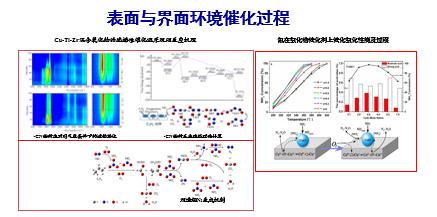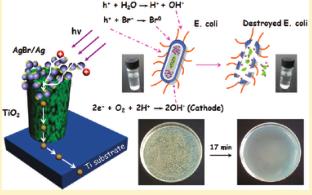

In situ spectroscopy was used to study the chemical and physical behavior of multi-scale surface interface of typical pollutants. Through the design and assembly of quantum dots and nanomaterials, heterogeneous catalysts with multi-element doping and multiple morphologies were constructed. In situ spectroscopy combined with reaction kinetics was used to realize in-depth study of relevant reaction mechanisms, reveal the role of active species, and develop new methods for reaction mechanism research. The research group proposed to explore the mechanism of surface interface charge transfer and the mechanism of photocatalytic purification of PTS molecules and microbial bacteria by using in-situ ultrafast spectroscopy. The Ag/AgBr/TiO2 ternary nanotube array electrode with enhanced visible light activity was prepared by electrochemical anodic oxidation and in-situ photo assisted deposition. Under visible light (λ > 420nm) inactivated Escherichia coli, evaluated the significantly enhanced photoelectric catalytic activity of the composite electrode, and its complete sterilization performance was far superior to other reference photocatalysts. PL, ESR and free radical capture studies show that hydroxyl radical is the main active oxygen species in the photocatalytic reaction. The damage process of cell wall and membrane was directly observed by ESEM, TEM and FTIR, and further confirmed by measuring the potassium ion leakage of killed bacteria. The current results show that OH•, O2•, from the outside to the inside of Escherichia coli, carry out oxidative attack, leading to cell death, which is the main mechanism of photocatalytic inactivation.

Environ. Sci. Technol. 2012, 46, 4042−4050; IF = 9.028;Top 1
Environ. Sci. Technol. 2010, 44, 5098–5103; IF = 9.028; Top 1
Environ. Sci. Technol. 2009, 43, 858–863; IF = 9.028; Top 1
Environ. Sci. Technol. 2009, 43, 7849–7855; IF = 9.028; Top 1
Adv. Funct. Mater. 2010,20, 2165–2174; IF = 18.808; Top 1
Applied Catalysis B: Environmental, 2016, 185: 1-10;IF = 19.503; Top 1
Journal of Materials Chemistry A, 2015, 3(43): 21655-21663;IF = 12.732; Top 1
Nanoscale, 2015, 7(39), 16282-16289;IF = 7.79; Top 1
J. Mater. Chem. C, 2015, 3, 6025;IF = 7.393; Top 1
Applied Catalysis B: Environmental, 2014, 156-157, 362-370;IF = 19.503; Top 1
ACS Applied Materials & Interfaces, 2014, 6, 671-679;IF = 9.229; Top 1
The Journal of Physical Chemistry C, 2014, 118, 10113-10121;IF = 4.126; Top 1
Journal of Materials Chemistry A, 2013, 1, 9060–9068;IF = 12.732; Top 1
Sensors and Actuators B: Chemical, 2017;IF = 7.420; Top 1
Chem Eng J, 2009,146, 30–35;IF = 13.273; Top 1
Langmuir, 2011, 27, 3113–3120;IF = 3.883; Top 1